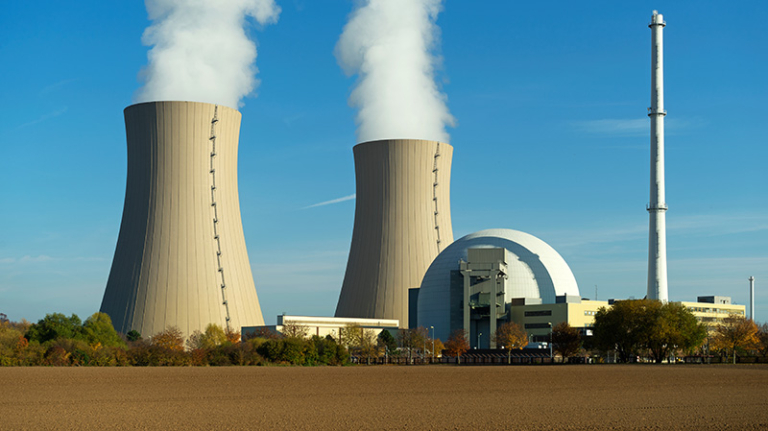Trump Administration’s Nuclear Energy Development Policy
Since the Trump administration, the United States has vigorously developed nuclear energy, with the aim of revitalizing the U.S. nuclear energy supply chain internally and strengthening technology transfer controls externally, in order to ensure U.S. national security and safeguard its global nuclear technological advantage, taking into account the U.S. goal of maintaining national nuclear technological capabilities and safeguarding U.S. nuclear technological advantage and competitiveness, which is mainly embodied in the Nuclear Energy Innovation and Modernization Act, the Advanced Nuclear Energy Technology Act, The Biden Administration’s policy on nuclear energy development has been reflected in a number of key policy documents, including the Nuclear Energy Innovation and Modernization Act, the Advanced Nuclear Energy Technologies Act, the U.S.-China Policy Framework for Civilian Nuclear Energy Cooperation, and the Advanced Reactor Development and Deployment Vision and Strategy.
The Biden Administration’s Nuclear Energy Development Policy
President Biden has aimed to revitalize the nuclear industry by advancing the nuclear supply chain, building nuclear alliance partnerships, and establishing a series of nuclear energy development programs and incentives.2021 Biden issued the Bipartisan Infrastructure Act, which involves $6 billion in funding for the U.S. Civilian Nuclear Credit Program to support the operation of domestic nuclear power plants and new construction. In addition, Biden issued the U.S. Inflation Reduction Act of 2022, which invests $369 billion to combat climate change and ensure energy security.
According to the Act, the future of the U.S. government will take a number of measures to support the development of nuclear energy, including: the implementation of tax credits for operating and new nuclear power plants, for the operating units, from 2024-2032, for the production of $ 0.015 per kilowatt hour tax credit, for new investment in nuclear power plants for the implementation of the 30% investment tax credit; for the Department of Energy (DOE) to provide $250 billion in funding loans and guarantees for the Department of Energy (DOE) to encourage the upgrading and restarting of clean energy facilities, including nuclear power plants; $700 million to help improve its domestic supply chain for high-abundance, low-enriched uranium (HALEU); and $150 million from DOE’s Office of Nuclear Energy to enhance U.S. nuclear energy research and development capabilities and to strengthen U.S. national laboratories’ infrastructure.
In addition, in recent years, the United States has also released a series of reports such as the Nuclear Supply Chain In-Depth Assessment Report and the Comprehensive Strategy for Maintaining Supply Chain Security to Vigorously Advance the Clean Energy Transition, which clearly set forth its major nuclear energy development directions:
First, promote life extension and new construction of domestic nuclear power plants. Keep domestic light water reactors in operation and extend their operating licenses, and complete the new construction program for large light water reactors.
Second, accelerate the deployment of advanced reactors by completing the Advanced Reactor Demonstration Program (ARDP), a $12 billion loan guarantee from DOE’s Loan Program Office to help complete the expansion of the Getler Nuclear Power Plant as well as to support the construction of the first U.S. Nuscale Small Reactor at the Idaho National Laboratory, which will utilize the infrastructure of an existing retired coal plant to build a small reactor to achieve the goal of building a new nuclear power plant in the United States. plant infrastructure to build a small reactor to repower the plant.
Third, establish a secure and reliable domestic HALEU supply chain. Support the construction of a domestic HALEU production plant to increase commercial HALEU production capacity and provide a reliable fuel supply for advanced reactors.
Fourth, selecting a site for a spent fuel storage facility, and currently seeking public input on potential sites.
Recent Overseas Market Development
U.S. Large Reactor Exports Achieve New Breakthroughs, AP1000 Nuclear Power Technology Expansion in European Market Accelerates.2022 In November 2022, the governments of the United States and Poland announced the establishment of a strategic partnership, in which the two sides will cooperate in the construction, operation and decommissioning of nuclear power plants, and the U.S. Westinghouse will help Poland build three AP1000 nuclear power units in the Lubiatowo-Kopalino in the Pomerania province. Lubiatowo-Kopalino in Pomeranian province, where Westinghouse will help Poland build three AP1000 nuclear power units. In addition to Poland, Westinghouse has signed agreements on cooperation in the field of large reactors with the Czech Republic and Ukraine.
Cooperation in the field of advanced reactors has blossomed. At present, the United States and Romania, Poland, the Czech Republic, Ukraine, Latvia, Estonia, Armenia, Ghana, South Africa, Kenya, Kazakhstan, the Philippines, Indonesia, Thailand and other countries have signed nuclear power cooperation agreements of varying degrees, mainly to Nuscale small reactors, BWRX-300, SMR-160, molten salt reactors and other reactor type cooperation, the footprint of overseas deployments throughout Europe, Central and Eastern Europe, Africa, Southeast Asia, Latin America and other regions.
Cooperation in the fuel sector is progressing. At this stage, the U.S. has carried out nuclear fuel and decommissioning cooperation with Ukraine, Bulgaria, the Czech Republic, Lithuania, Finland and other countries. Westinghouse will provide nuclear fuel for Bulgaria’s Kozloduy No. 5 nuclear power unit, and has signed an agreement with the Czech Republic’s EZ Company to supply fuel assemblies for its Temelin nuclear power plant.
Recent U.S. International Cooperation
Creating close “allies and partners” in the international nuclear power industry. In recent years, the U.S. has strengthened cooperation with some major nuclear power development countries in the field of nuclear power, and South Korea in nuclear power construction, decommissioning, nuclear equipment, nuclear technology applications, nuclear fuel, joint exports to third countries and other areas of cooperation; with Canada, the United Kingdom, Japan and other countries in the deployment of small reactors in the increasingly closer cooperation, the interests of the bundling of the closer, the areas of cooperation, including investment, design review, joint R & D, equipment manufacturing, etc.; with Spain on the joint production of V In addition, the United States has also strengthened cooperation with Canada, the United Kingdom and France in the field of nuclear fuel, such as uranium conversion, in order to reduce the dependence on Russian nuclear fuel. The above initiatives on the one hand, through the strong combination, accelerate the improvement of the U.S. nuclear energy supply chain, and improve the autonomy. Strive for international discourse in the field of U.S. nuclear energy. The U.S. Strategic Vision for Nuclear Energy 2021 report clearly proposes to enhance its participation in international nuclear energy organizations and gain a leadership position. Therefore, the U.S. actively utilizes the platforms of international organizations such as the International Atomic Energy Agency (IAEA) to actively participate in the global governance of the nuclear sector through the release of initiatives, the conduct of conferences and special working groups, etc., so as to create international discourse in the field of nuclear energy for the U.S., to influence the formulation of international nuclear power technology standards, and to pave the way for the entry of its nuclear power technology into the international market.
Key Development Strategies
In recent years, the United States has developed initiatives to obtain overseas orders, including providing favorable policy and financial support for nuclear power exports, aggressively promoting the development and deployment of advanced reactors, strengthening the nuclear energy supply chain, working closely with other major nuclear power countries to create close alliances in the international nuclear power industry, and deterring competitors.
The government provides diplomatic and financial support for nuclear power exports.
The U.S. has vigorously promoted nuclear power exports in recent years, and according to DOE’s February 2022 Nuclear Supply Chain In-Depth Assessment, expanding exports of advanced nuclear power technologies is one of its long-term goals for future nuclear power development. To this end, the U.S. has actively promoted nuclear power technology exports through high-level government diplomacy, and cooperation in the field of nuclear energy has become one of the common topics of its visits.2022, U.S. President Joe Biden during his visit to South Korea and Japan, and Vice President Harris during his visit to Thailand, the Philippines, Poland and other countries have been negotiating on cooperation in the field of nuclear energy and reached a consensus.
In addition, the inability to provide attractive financing packages has been seen as a potential obstacle to the export of U.S. nuclear technology, for which the U.S. 2020 officially lifted the ban on grants from the International Development Finance Corporation (DFC) for overseas nuclear energy projects. In an effort to solidify cooperation with Romania in the nuclear energy sector, the U.S. Export-Import Bank has also provided $3.05 billion in funding for the construction of the Cernavoda nuclear power plant, as well as $14 million to work with Romania on small reactor technology. The lifting of the appropriations ban provides strong financing support for the U.S. to acquire overseas orders, while the U.S. bank’s provision of nuclear technology research funding to the market country also lays the foundation for cooperation in its later acquisition of nuclear energy programs.
Strengthen the absolute leading global nuclear technology capability and seize the market through nuclear power technology advantages.
Currently, the U.S. has launched the Advanced Reactor Demonstration Program (ARDP), under which the U.S. government will provide approximately $160 million in initial funding support for selected advanced reactor demonstration projects, and has introduced the Accelerating the Deployment of Multifunctional, Advanced Nuclear Clean Energy in 2023 Act, which is intended to support the deployment of U.S. nuclear technology at home and abroad by providing regulatory support, promoting the reuse of conventional energy sites and other measures (a bill is still being introduced). deployment (the bill is still in the introductory stage). Currently, the U.S. government has provided strong financial support to a number of local companies and national laboratories for small reactor technology research and development, commercial deployment, and the construction of advanced reactor fuel plants, etc., to enhance the supply and guarantee capabilities for advanced small reactors, improve the relevant supply chain, and seek to seize the strategic high ground of global nuclear science and technology innovation, and to promote the export of small reactors by promoting exports from within.
Reinventing alliance partnerships and obtaining orders through geopolitical influence.
On the one hand, the U.S. is actively expanding the market of its inherent allies, strengthening nuclear energy cooperation with South Korea, jointly developing the nuclear power market of third countries, and signing cooperation agreements in the field of nuclear energy with many European countries.
At the same time, increase the nuclear power emerging markets of capital and technology research and development support, the development of a variety of nuclear power field cooperation programs, trying to Africa, Southeast Asia, Eastern Europe, South America and other regional market countries into their own camp, the formation of U.S. nuclear power technology as the core of the United States of America’s joint development circle. For example, the United States has put forward the “Infrastructure for the Responsible Use of Small Modular Reactor Technology Program” (FIRST), and has been actively publicizing it to various market countries. At present, Estonia, Ghana, Japan, Kazakhstan, Latvia, the Philippines, South Korea, Romania, Ukraine and other countries have issued a joint statement with the United States that they will join the U.S. FIRST program, which opens up a new situation for the United States to subsequently promote the landing of its small reactor technology in the above market countries.
On the other hand, the U.S. and its allies have adopted the means of diplomatic alliance, by virtue of political pressure as well as the guidance of interests, to squeeze the competitors’ space for overseas market development activities on a global scale. Looking at China and Russia in Romania, Poland, the Czech Republic, the United Kingdom, Finland, nuclear power projects blocked behind, there is no lack of U.S. manipulation of the figure.
Measures to Curb Competitors
Export controls, as well as sanctions, have been used to limit competitors’ nuclear energy development.DOE’s report, “Reshaping U.S. Nuclear Energy’s Competitive Advantage: A Strategy for Ensuring U.S. National Security,” suggests that the United States should take steps to suppress the development of nuclear power in China and Russia, and to move into the markets that are currently controlled by state-owned enterprises in both countries.20 In February 2022, DOE released its “In-Depth Evaluation of the Nuclear Energy Supply Chain,” which re-emphasized that the United States must implement targeted policies to fend off competition from countries like China and Russia. The U.S. has in recent years exposed competitors to the risks of international supply chain isolation, financial blockades, and damage to corporate image through technology export controls, financial sanctions, and public opinion smears. As a result, competitors’ partners have avoided or suspended cooperation with them for fear of collateral sanctions, broken financial chains, reduced performance ability, public opinion and other factors, thus creating a window of opportunity for the U.S. to enter competitors’ nuclear power market.
Squeezing other countries’ nuclear power technology overseas through intellectual property layout. At present, the international nuclear power market competition is becoming increasingly fierce, the United States, France, Russia and other traditional nuclear power countries actively layout of overseas intellectual property rights system, with the help of patents first seize the overseas nuclear power market. In the future, it is not ruled out that the U.S. and Western nuclear power enterprises will seize certain non-critical design points to carry out strategic patent layout, which will bring infringement risks for their competitors to develop relevant overseas markets.
Build a nuclear energy supply chain system that excludes China and Russia. In recent years, the United States to strengthen cooperation with some of the major nuclear energy countries, and gradually establish its international nuclear energy competition alliance, plans to build a nuclear energy supply chain system dominated by Europe and the United States, so as to get rid of the dependence on China and Russia in the nuclear energy supply chain. For example, in March of this year, Biden and Canadian Prime Minister Justin Trudeau reached a consensus on the development of a safe and reliable nuclear fuel supply chain in North America and the establishment of partnerships. Although the U.S. and Western countries have not explicitly rejected cooperation with China, they have initially shown isolation from China, and the process of cooperation with major nuclear energy countries may be affected to some extent in the future.
Countermeasures and Recommendations
Actively promote high-level government diplomacy. The U.S. has elevated nuclear energy cooperation to a national strategy. Therefore, it is recommended that the U.S. actively promote the inclusion of nuclear energy cooperation into the topics of bilateral and multilateral leaders’ talks or governmental cooperation mechanisms, so as to promote the implementation of cooperation in the field of nuclear energy through high-level governmental diplomacy, and at the same time, assign nuclear energy commissioners to our key countries’ missions abroad or provide them with the ability to do so. For countries with in-depth cooperation, it is suggested that nuclear energy counselors or nuclear energy commissioners be posted to our missions abroad; for key market-tracking countries with a certain foundation of nuclear energy cooperation, it is suggested that embassies abroad be given the function of publicizing and promoting nuclear energy technology.
Strengthen nuclear energy cooperation with major nuclear power countries and international organizations. It is recommended to systematically sort out the potential areas of cooperation with relevant major nuclear power development countries, actively establish international nuclear energy partnerships and form synergies to create a community of interests, and enhance the competitiveness of China’s nuclear power exports by complementing each other’s strengths.
In addition, we should make full use of the channels of international professional organizations such as IAEA, the World Association of Nuclear Power Operators (WANO) and the World Nuclear Association (WNA), and deeply participate in the formulation of rules and international issues in the international nuclear field, the development of standards for small reactors, etc., and actively participate in the global governance of the field of nuclear energy, and further enrich the forms of cooperation with international organizations, such as dispatching more specialists to take up important positions in international organizations, and Jointly organize international conferences, conduct cooperative training, etc., and through such activities participate more deeply in international affairs, so as to continuously enhance China’s influence and voice in global nuclear energy governance.
Propose international cooperation initiatives in the field of nuclear energy under our leadership. The U.S. has launched the FIRST program and is actively expanding it to its partner and market countries. It is suggested that we can consider taking the opportunity of organizing international conferences to put forward cooperation plans or initiatives in the field of small reactors and other areas under our leadership, equipped with corresponding funds, and discussing cooperation in international standard-setting, joint research and development of technologies, market development and other aspects with potential partner countries and market countries, so as to enhance our appeal and steer the direction of the development of nuclear energy.





